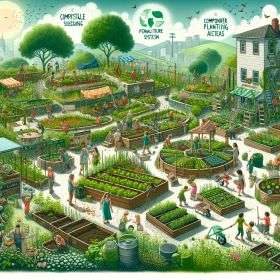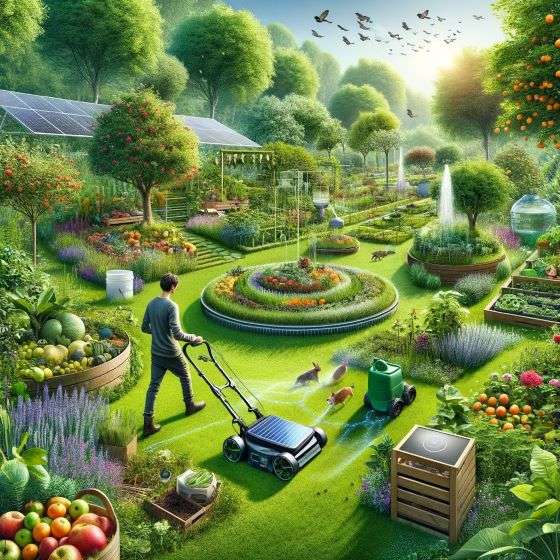This post contains affiliate links, through which we may earn a commission at no additional cost to you.
Table of Contents
Introduction
Within permaculture’s verdant and flourishing domain, the standard lawnmower finds itself as misplaced and unnecessary as a teapot constructed from chocolate. Welcome to the intriguing realm of “11 Permaculture Techniques,” an odyssey into the innovative and exceptionally effective gardening world that adheres to sustainability principles. Here, the intrusive noises and the environmental repercussions of gas-powered mowers are substituted with intelligent, eco-friendly alternatives. This manual explores many inventive strategies that foster our gardens and synchronize with the Earth’s inherent rhythms. Prepare to dive into the practice of permaculture, where the usual gardening apparatuses are envisioned anew for a flourishing Earth.
1. Sheep: The Furry Lawnmowers

Why own a lawnmower when you can have sheep? These fluffy critters are nature’s lawn care experts. Simply let them graze, and voilà – your lawn is trimmed and fertilized simultaneously. Not only do you get a manicured lawn, but also wool and maybe some cheese. Check out “The Joy of Keeping Sheep” by Laura Childs, for a delightful introduction to sheep keeping.
Consider the fuss and bother of dealing with a lawnmower unnecessary when you could easily opt for the assistance of sheep. These adorable, fluffy beings are a natural approach to keeping your lawn in pristine condition. By permitting them to wander and graze on your property, you have your grass trimmed neatly and fertilized organically, all without effort. Besides the practical advantage of having a yard looked after without any hassle, sheep offer more benefits, such as providing wool for your crafts and even the chance to make cheese at home.
For anyone fascinated by making these multifaceted animals a part of their daily existence, “The Joy of Keeping Sheep” by Laura Childs is a detailed and captivating manual to initiate your herd. Furthermore, including “Sheepish: Two Women, Fifty Sheep, and Enough Wool to Save the Planet” by Catherine Friend in your collection will give you a funny yet profound perspective on the experiences and learnings that come with growing close to these lovable creatures. Together, these publications offer a clear depiction of the pleasures and the practicalities of sheep rearing, presenting a solid argument for preferring these eco-friendly garden keepers over traditional gardening equipment.
2. Edible Ground Covers: Nature’s Carpet
Wave goodbye to the traditional, labor-intensive lawns that belong to the past and say hello to the groundbreaking idea of using edible ground covers. Imagine your outdoor areas being transformed by a lush layer of fragrant thyme or calming chamomile – these alternatives demand minimal care while providing the utmost sensory pleasure. The mere thought of stepping outdoors into a setting where each step unleashes a delightful, herbaceous scent is captivating. Additionally, the appealing notion of possessing a lawn serving as a herb garden is too adorable to ignore. It goes beyond mere looks; it represents a functional shift in our engagement with the surrounding environments.
This idea is beautifully delved into in “Edible Landscaping” by Rosalind Creasy, an innovator who has led the way in this transformative gardening method. Her work reveals a garden world not just focused on plant aesthetics but on incorporating them into our meals and daily lives in ways that are both sustainable and immensely satisfying. Creasy’s perspectives invite gardeners to challenge conventional gardening ideas, championing a garden that feeds the body, pleases the senses, and soothes the soul. Guided by her expert advice, readers are shown how to craft landscapes as plentiful and resourceful as they are enchanting, turning the vision of a vibrant, edible paradise into an achievable dream.
3. Companion Planting, one of the best permaculture Techniques: The Plant Buddy System

Explore the intricate art of companion planting, likened to a plant kingdom’s version of Tinder. This technique involves forming pairs among plant species in mutualistic relationships, aiding each other in critical ways, including natural pest repellence, enhanced pollination, and better growth rates. Visualize marigolds with their vivid, inviting flowers, positioned as protectors around tomato plants, driving away injurious nematodes and bugs with their strong scent. Or envision basil, with its fragrant leaves, placed among lettuce, keeping pests at bay while possibly boosting its companion’s taste. It extends beyond mere practical advantages; it’s about forging perfect matches in the garden universe, where each plant enhances its neighbor’s life, leading to a more fruitful and balanced garden ecosystem.
Louise Riotte’s “Carrots Love Tomatoes” beautifully investigates the concept of companion planting. Riotte’s book dives into the wide-ranging partnerships within the plant world that surpass basic combinations like marigolds with tomatoes or basil with lettuce. It presents the notion that carrots and tomatoes flourish together, with the carrots’ fine foliage helping to make the soil more porous, thus enabling tomato roots to delve deeper. Likewise, beans sown near corn not only use the corn stalks for support but also enrich the soil with nitrogen, which corn greatly benefits from. The exploration doesn’t end there; the publication unveils unexpected alliances like nasturtiums and cucumbers, where the former’s spicy flowers draw in pollinators and might keep cucumber beetles at bay.
4. Keyhole Gardens: Small Space, Big Impact
Hailed as the multitool of horticulture, keyhole gardens are a testament to creative innovation, perfectly suited for those battling scarce space. These round, elevated planting areas shine with a compost basket at their heart, showcasing not only a high yield potential but also a blueprint for water conservation. The clever design permits a varied collection of compostable household leftovers and yard debris to be directly converted into fertile soil, nourishing the garden from its core. They stand out for city dwellers aiming to optimize their harvest in limited areas, creating a vibrant, green haven amid urban sprawl.
The book “Soiled Totten: Keyhole Gardens All Year Round” by Deb Tolman, PhD, and G. Elaine Acker dive into the detailed craft and knowledge behind building and sustaining these miniature ecosystems. It walks you through the entire journey of cultivating a flourishing garden capable of supporting a broad spectrum of vegetation. Leafy vegetables such as kale and Swiss chard flourish in the nutrient-rich soil, while bright blooms like marigolds and nasturtiums contribute bursts of color and draw in friendly pollinators. Thus, keyhole gardens are versatile, able to host an array of plant life.
5. Rainwater Harvesting: Nature’s Gift
Harvesting rain isn’t only for those with vast farmland expanses; anyone can partake in this environmentally friendly endeavor. You can effectively collect rainwater for your garden’s needs with a simple setup that includes a barrel. This practice aids in reducing your water bills and positively impacts the environment by lessening the strain on city water resources and decreasing pollution from runoff.
To gain a deeper understanding of this eco-conscious practice, Brad Lancaster’s “Rainwater Harvesting for Drylands and Beyond” offers a thorough investigation. Moreover, “The Water-Wise Home: How to Conserve, Capture, and Reuse Water in Your Home and Landscape” by Laura Allen delivers essential information on additional innovative ways to handle and recycle water in your residence and garden. Together, these guides provide the necessary knowledge to implement successful rainwater harvesting strategies, benefitting your finances and the earth.
6. Worm Composting: Waste Not, Want Not
Initiate a green path by transforming your kitchen scraps into fertile compost with the intriguing vermicomposting method. This technique is astonishingly straightforward and utterly free from foul odors, which is lovely. It presents a phenomenal opportunity to replenish your garden’s soil, promoting your plants’ health and growth. The foundational book by Mary Appelhof, “Worms Eat My Garbage,” is a perfect guide that provides a detailed process of establishing and maintaining a vermicomposting system.
Moreover, for those looking to expand their knowledge and capabilities in composting, “The Worm Farmer’s Handbook” by Rhonda Sherman is another essential guide. This publication delves more into the nuances of vermicomposting, equipping newcomers and experienced individuals with the necessary skills to easily convert their organic refuse into a valuable asset for their garden, often called ‘black gold.’
7. Hügelkultur: The Mound of Plenty
Hügelkultur, the ancient practice of creating raised garden beds over a mound of decaying wood, is a permaculture gem and one of the best permaculture techniques. It improves soil fertility and water retention. To get started, “Sepp Holzer’s Permaculture” by Sepp Holzer is a fantastic resource.
8. Solar Cooking: Harness the Sun

Why cling to the outdated, power-hungry conventional ovens when the sun, a boundless and eco-friendly energy supplier, is nudging us? Solar cooking showcases human ingenuity by harnessing the sun’s rays, offering a method to prepare everything from simple breads to intricate dishes. Notably, it is extremely efficient, light on expenses, and grabs the attention of eco-conscious individuals. The book “Cooking with Sunshine” by Lorraine Anderson is not merely a collection of recipes; it serves as a comprehensive manual to this novel approach of food preparation. It captures your curiosity, providing a valuable instrument for those eager to dive into a solar-powered culinary adventure.
But there’s even more! Beyond a basic introduction to solar cooking, the book encourages exploring a vast array of dishes. Envision robust stews, succulent roasts, hearty bread, and exquisite desserts. Taste the sun-kissed blend of flavors in a ratatouille, with tomatoes, zucchinis, eggplants, and peppers merging wonderfully. Or indulge in a lusciously moist, sun-baked banana bread that champions sustainability. Anderson’s book further explores the versatility of solar cookers in preparing grains such as quinoa, rice, lentil beans, and even pasta, showcasing their capability to handle a wide variety of ingredients. On overcast days, the sun still proves to be an invaluable component for any recipe!
9. Permaculture Guilds: The Ultimate Team
In permaculture, a guild is a group of plants and animals harmoniously working together. By understanding these relationships, you can create a thriving ecosystem in your backyard. “Gaia’s Garden” by Toby Hemenway is a must-read for understanding guilds. This is one of the premier permaculture techniques to delve into and explore further.
10. Natural Pest Control: Goodbye, Chemicals!
Swap out the harsh, man-made chemicals for the soothing touch of organic pest management, an approach where each issue is met with a sustainable solution. From the voracious appetite of ladybugs feasting on aphids to the moth-deterring fragrance of lavender flowers, the natural world is equipped with an intricate defense system against typical garden invaders. The insightful publication, “Attracting Beneficial Bugs to Your Garden” by Jessica Walliser, reveals the untapped potential of using live organisms for pest control. Walliser extends an invitation to a broad range of helpful insects, like praying mantises that devour annoying bugs, nematodes that combat underground pests, and bees that not only aid in pollination but also keep certain intruders at bay.
Moreover, plants like marigolds release odors that fend off nematodes and whiteflies, whereas chives can deter aphids and even boost tomatoes’ taste if planted nearby. Garlic is an all-encompassing pest repellent, including spider mites, aphids, and Japanese beetles. In addition, incorporating herbs such as basil and rosemary infuses your food with flavor and acts as a barrier against mosquitoes and flies. This comprehensive strategy goes beyond just warding off pests; it involves cultivating an ecosystem where predatory and pollinating insects can flourish, ensuring your garden remains a lively, well-balanced environment.
Walliser’s manual sheds light on the journey toward a garden where each plant and insect contributes essential roles, turning your outdoor space into a haven of biodiversity. By heeding the advice in her book, you’ll be partnering with nature, nurturing a garden that not only flourishes but also stands as a symbol of ecological responsibility.
11. Community Sharing: Together We Grow

Last but not least, community sharing. Community resources can significantly enhance your permaculture journey from seed swaps to tool lending libraries. Join local gardening groups or visit platforms like ShareWaste to connect with like-minded individuals.
Conclusion
Permaculture transcends merely gardening; it is an integrated approach toward coexisting peacefully with our surroundings. By implementing these 11 Permaculture Strategies, you engage in more than enhancing the vigor and yield of your garden. You contribute significantly to the wellness and durability of our globe. These strategies, rooted in the concepts of ecological equilibrium and the conservation of resources, allow for the development of a fruitful and attractive garden, all while reducing your environmental impact.
Envision possessing the most eye-catching garden in your vicinity, a lush haven flourishing naturally, devoid of the disturbing sounds and contamination from a conventional lawnmower. This scenario becomes achievable when you adopt permaculture not solely as a gardening technique but as an all-encompassing lifestyle choice that boosts the health of the planet and its residents.
FAQs on Permaculture Techniques
How can I control pests in my permaculture garden naturally?
Foster a habitat that attracts insects and animals, which is beneficial for controlling pest populations by planting species like ladybugs, lacewings, and enticing birds. Employ companion planting as a natural deterrent for pests; an example would be using marigolds to fend off nematodes and basil to keep tomato pests at bay. Implementing physical barriers, such as row covers, protects your plants without the need for damaging chemicals.
How do you save water in your permaculture garden?
Set up a system for collecting rainwater off your roofs, enabling you to store it in barrels or large containers. Surrounding your vegetation with mulch helps reduce evaporation, and a drip irrigation system targets the root zone directly, thereby reducing unnecessary water usage.
What is a Simple Method to Improve My Garden’s Soil Fertility Without Using Chemical Fertilizers?
Make your compost using leftover food, garden debris, and other biodegradable materials. This process not only helps manage waste but also significantly enhances the nutrient content and structure of the soil, fostering healthy microbial life.Moreover, rotating your crops and planting species that fix nitrogen, like beans and peas, can naturally restore the fertility of your soil.
Can Permaculture Techniques Improve Soil Health? How?
Certainly, permaculture techniques can markedly enhance the health of the soil through strategies that improve its structure, enrich its fertility, and boost its biological variety. Composting adds rich organic substances and helpful microbes, increasing the soil’s nutrient levels and vivacity. Applying mulch helps to keep moisture in, reduce weed growth, and slowly improves the ground as it breaks down. Furthermore, employing cover crops like legumes and various other plants helps control nitrogen fixation and erosion. When plowed back into the soil, it contributes organic matter, enhancing its texture and fertility.
How Can Permaculture Techniques Combat Climate Change?
Permaculture techniques solve climate change by adopting eco-friendly farming practices that boost biodiversity, enhance soil quality, and diminish greenhouse gas emissions. By replicating the structures of natural ecosystems, permaculture plans incorporate a mix of trees, bushes, and ground foliage to trap carbon within the soil, an essential step for the depreciation of CO2 levels in our air. Strategies like creating compost, applying mulch, and favoring perennial vegetation nourish the soil and escalate its ability to store carbon.








